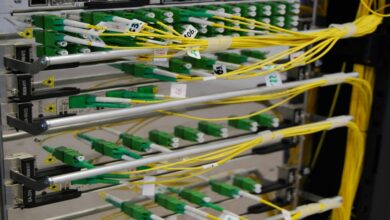The Future of Security: 7 Cutting-Edge Technologies Every Business Owner Should Consider

In today’s rapidly evolving digital landscape, staying one step ahead of cyber threats is essential for businesses of all sizes. From AI-powered threat detection to blockchain encryption, the future of security is filled with cutting-edge technologies that can help protect your business from potential breaches. Let’s explore 7 innovative security solutions that every forward-thinking business owner should consider implementing to safeguard their data and assets in the years to come.
The Importance of Security in the Digital Age
The importance of security cannot be overstated in the current landscape where cyber attacks are becoming increasingly sophisticated and prevalent. According to a study by IBM Security, the average cost of a data breach for a company is now $3.86 million, with an average global probability of 27.7% over the next two years for any organization experiencing a material data breach.
Not only do these attacks result in significant financial losses, but they can also damage a company’s reputation and erode customer trust. In today’s highly competitive market, maintaining a strong brand image is crucial for businesses to stay ahead. Any breach or compromise of sensitive information can lead to negative publicity and decrease customer loyalty.
Moreover, as more businesses shift towards remote work due to the COVID-19 pandemic, ensuring the security of online networks and devices has become even more critical. With employees accessing company data from outside networks and devices that may not have the same level of protection as office networks, vulnerabilities increase exponentially.
What is Cutting-Edge Technology?
Cutting-edge technology refers to the latest and most advanced tools, systems, and methods that are currently available in a particular field. These technologies are constantly evolving and pushing the boundaries of what was previously thought possible. In the context of security, cutting-edge technology involves incorporating innovative solutions to protect businesses from potential threats.
One of the key characteristics of cutting-edge technology is its ability to improve upon existing processes and systems by introducing new features or enhanced capabilities. This can include things like artificial intelligence (AI), machine learning, advanced analytics, automation, and more. By harnessing these technologies, businesses can stay ahead of potential risks and strengthen their overall security posture.
The development and adoption of cutting-edge technology in the realm of security have been driven by several factors. Firstly, the increasing sophistication of cyber threats has forced businesses to look for more advanced ways to protect their data and assets. Traditional security measures such as firewalls and antivirus software are no longer sufficient in preventing attacks from highly skilled hackers.
Furthermore, with the rise of remote work arrangements due to the COVID-19 pandemic, there has been an urgent need for secure remote access solutions that can handle large volumes of traffic without compromising on speed or reliability. This has led to the emergence of new technologies such as zero-trust architecture, which allows organizations to verify every user’s identity before granting them access to sensitive data.
Another important aspect driving the adoption of cutting-edge technology is compliance requirements. As regulations surrounding data protection become stricter and penalties for non-compliance increase, businesses must invest in modern security solutions that meet regulatory standards.
Biometric Authentication: Enhancing Security with Fingerprint and Facial Recognition
Biometric authentication has emerged as a powerful tool in enhancing security measures for businesses. With the increasing rate of cyber and physical threats, traditional methods of protection such as passwords and PINs have become increasingly vulnerable to hacking and manipulation. Biometric authentication offers an added layer of security by using unique human characteristics that are difficult to replicate or forge.
One of the most widely used biometric technologies is fingerprint recognition. This technology relies on scanning and analyzing the unique ridges and patterns on a person’s fingertips. These patterns are unique to each individual, making it virtually impossible for someone else to use another person’s fingerprints for fraudulent purposes.
Fingerprint scanners are being widely adopted by businesses due to their ease of use and high accuracy. They can be integrated into various devices such as laptops, smartphones, and access control systems, making them convenient for employees to use in their daily operations. Additionally, fingerprint scans leave no room for human error or forgetfulness, unlike passwords which can be easily forgotten or shared.
Facial recognition is another popular form of biometric authentication that is gaining traction in the business world. It works by capturing an image or video of a person’s face and comparing it with previously stored data in a database. The technology utilizes advanced algorithms that analyze facial features such as structure, shape, and distance between key points like eyes, nose, mouth, etc., to create a unique identification profile.
One notable advantage of facial recognition technology is its non-contact nature. Employees do not need to physically touch any device or surface for verification; instead, they can simply look at the camera for authentication. This makes it highly hygienic – particularly important during pandemic times – as no physical contact or exchange is required.
Moreover, facial recognition provides real-time verification with high accuracy rates compared to traditional methods like ID cards or PINs which can be easily lost or stolen. It also eliminates “buddy punching” where one employee clocks in/out for another, leading to time theft and inaccurate attendance records.
However, while biometric authentication offers advanced security measures for businesses, concerns regarding privacy and data protection have been raised. To address these concerns, it is essential for businesses to adhere to strict regulations and guidelines when collecting and storing biometric data. Additionally, implementing multi-factor authentication with a combination of biometrics and traditional methods can further enhance the security of sensitive information.
Artificial Intelligence: Utilizing Machine Learning for Threat Detection and Prevention
The traditional approach to security involves creating rules and policies based on known patterns of attacks or vulnerabilities. However, with constantly evolving threats and sophisticated cyberattacks, this method has proven to be ineffective. This is where artificial intelligence comes into play. By using algorithms to analyze large volumes of data from multiple sources, AI can identify patterns and anomalies that may indicate potential threats or breaches.
Moreover, AI’s self-learning abilities allow it to adapt to new types of attacks quickly. As new data becomes available, the algorithm can analyze it and adjust its detection methods accordingly. This constant evolution enables businesses to stay ahead of emerging threats and prevent them before they cause any harm.
One example of utilizing machine learning for threat detection is anomaly detection. With AI-powered anomaly detection systems, businesses can monitor their networks for abnormal behavior in real-time. These systems take into account various factors such as device activity patterns, user behavior patterns, network traffic patterns, etc., to establish what “normal” looks like within an organization’s environment.
Once established, any deviations from these norms are flagged as potential threats and investigated further by security teams. This helps organizations identify suspicious activities early on and take necessary steps before they escalate into full-fledged attacks.
Another way AI is being utilized for cybersecurity is through predictive analysis. By using historical data and analyzing trends over time, AI can make predictions about possible future threats or vulnerabilities that may arise in a specific system or organization. With this information at hand, businesses can proactively take measures to secure their systems and prevent potential attacks.
Furthermore, AI-powered security systems can also automatically respond to threats in real-time. By leveraging machine learning algorithms, these systems can determine the best course of action to take when faced with a threat. This not only minimizes human error but also reduces response time significantly, allowing businesses to mitigate risks before they escalate.
Blockchain Technology: Revolutionizing Data Protection and Access Control
Blockchain technology has been attracting a lot of attention in recent years, and for good reason. Originally known as the underlying technology behind cryptocurrency such as Bitcoin, blockchain has evolved to become a revolutionary tool in the world of data protection and access control.
But what exactly is blockchain? In simple terms, it is a digital ledger that records and stores data in a secure and immutable manner. Each block in the chain contains time-stamped and encrypted information, creating an unalterable record of all transactions or interactions on the network. This makes it virtually impossible to tamper with or manipulate any stored data without detection.
One of the key benefits of blockchain technology is its decentralized nature. Unlike traditional databases where information is stored on one central server, blockchain utilizes a distributed network where data is spread out among multiple nodes. This means there is no single point of failure, making it highly resilient to cyber attacks.
This decentralized structure also eliminates the need for intermediaries when exchanging data, reducing costs and increasing efficiency. With blockchain, businesses can securely share sensitive information with partners, suppliers or customers without compromising their security.
Moreover, since each block contains cryptographically-linked information from the previous block, attempting to alter any part of the chain would require immense computational power that makes it practically impossible to hack into or corrupt the system.
In addition to protecting data from external threats, blockchain also offers advanced access control capabilities. Through smart contracts – self-executing contracts with terms written into code – businesses can control who has access to certain information on the network based on predefined conditions. For example, only authorized parties will have access to specific files or documents if they meet certain criteria such as paying a fee or meeting certain requirements.
Virtual Private Networks (VPN): Securing Communication and Data Transfer
Virtual Private Networks (VPN) have become an essential tool for securing communication and data transfer in today’s digital landscape. With the rise of remote work and online transactions, businesses are increasingly relying on VPNs to protect their sensitive information from cyber threats.
So, what exactly is a VPN? In simple terms, it is a network that allows users to access the internet securely and privately. It creates a secure tunnel between the user’s device and the internet, encrypting all data that passes through it. This means that any third party attempting to intercept or access this data will only receive encrypted gibberish instead of valuable information.
One of the most significant advantages of using a VPN is its ability to mask your IP address. By connecting to a remote server located in a different geographical location, your actual IP address is concealed, making it nearly impossible for hackers or government agencies to track your online activities. This added layer of security is especially crucial when accessing public Wi-Fi networks, which are notorious for their vulnerabilities.
Another critical feature of VPNs is their end-to-end encryption. Unlike traditional networks where data can be intercepted at various points during transmission, VPNs use advanced encryption algorithms to ensure that all information remains confidential while in transit. This makes them an ideal solution for businesses dealing with sensitive financial and personal data such as banking institutions or healthcare organizations.
In addition to securing communication channels, many companies use VPNs as a means of creating private networks within their organization’s infrastructure. These “intranets” allow employees to safely access company servers and databases remotely while working from home or traveling without compromising security protocols. Furthermore, with more businesses adopting cloud-based services for storing critical files and applications, using a VPN adds an extra layer of protection against unauthorized access.
Cloud-based Security Solutions: Protecting Data on the Cloud
Cloud-based security solutions refer to software or services that are deployed in the cloud to protect sensitive data and information stored on remote servers. These solutions use advanced technologies such as encryption, firewalls, and threat intelligence to safeguard against potential cyber threats.
One of the key advantages of using a cloud-based security system is its ability to provide real-time protection for data stored in the cloud. As these systems run continuously, they can identify any suspicious activity or unauthorized access instantly, allowing businesses to respond quickly and mitigate potential risks.
Moreover, these solutions offer multi-layered protection through various levels of authentication processes such as passwords, biometric verification, and tokenization. This provides an additional layer of security for sensitive data access.
Additionally, most cloud-based security systems offer regular updates and patches to address emerging threats and vulnerabilities. This ensures that businesses are equipped with cutting-edge defense mechanisms to combat constantly evolving cyber attacks.
Another major benefit of opting for a cloud-based security solution is its cost-effectiveness. With traditional on-premises security systems requiring significant investments in hardware infrastructure and maintenance costs, small businesses can find it challenging to keep up with evolving cybersecurity needs. Cloud-based security eliminates this barrier by offering pay-as-you-go plans or flat monthly rates that fit into any budget.
Furthermore, with employees increasingly working remotely and accessing company networks through multiple devices from different locations, securing all endpoints has become critical for businesses’ overall cybersecurity strategy. Cloud-based security offers centralized management options that enable administrators to control network access wherever their employees work from within a single intuitive interface.
Internet of Things (IoT) Security
The growing use of connected devices, from smart homes to industrial machinery, has led to the rise of the Internet of Things (IoT). This technology refers to the network of physical objects embedded with sensors, software, and other technologies that enable them to collect and exchange data. While IoT provides numerous benefits, it also brings new security challenges for businesses. With an increasing number of devices being interconnected, the potential for cyber attacks targeting these devices is a major concern.
One reason why IoT devices are vulnerable to security breaches is their lack of robust security measures. Unlike traditional computers and networks which have built-in security features like firewalls and anti-virus software, many IoT devices have limited computing power and memory. As a result, they often do not have sophisticated security protocols in place. This makes them easy targets for hackers who can exploit their vulnerabilities.
Another challenge with securing IoT devices is their widespread deployment across different industries such as healthcare, transportation, and energy. Each industry has its own unique set of regulations and standards for protecting sensitive data. Ensuring compliance across all sectors is crucial in maintaining overall security in an increasingly interconnected world.
Furthermore, manufacturers often prioritize functionality over security when developing IoT devices due to intense competition in the market. As a result, many products are released with known vulnerabilities that can be easily exploited by hackers if left unaddressed.
To address these challenges and ensure secure usage of IoT technology in businesses, proactive measures must be taken by business owners:
1) Ensure regular software updates: Regularly updating the firmware or software on all connected devices can help protect against known vulnerabilities.
2) Implement strong passwords: By using complex passwords or implementing two-factor authentication methods, businesses can reduce their vulnerability to cyber attacks.
3) Secure gateways: Gateways act as intermediaries between connected devices and external networks; securing them with encryption methods can help prevent unauthorized access.
4) Monitor network traffic: Implementing intrusion detection systems and monitoring network traffic can help detect suspicious activity early on and prevent potential cyber attacks.
5) Training and awareness: Ensuring that employees are aware of the potential security risks associated with IoT devices is crucial in preventing human errors that could lead to breaches.
As the use of IoT devices becomes more prevalent in businesses, it is important to prioritize their security. By implementing proactive measures and staying informed about emerging threats, business owners can mitigate the risks associated with using these cutting-edge technologies.
Conclusion
As technology continues to advance at a rapid pace, it is crucial for business owners to stay ahead of the curve when it comes to security. By implementing cutting-edge technologies such as artificial intelligence, blockchain, and biometrics, businesses can better protect their sensitive data and assets in an increasingly digital world. The future of security is constantly evolving, and by being proactive and investing in these technologies now, businesses can ensure a more secure tomorrow. Don’t wait until it’s too late – start considering these innovative solutions for your business today.





